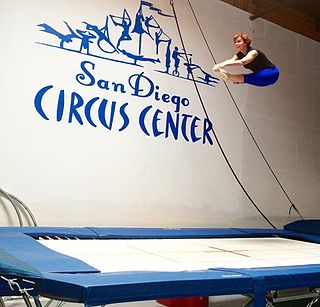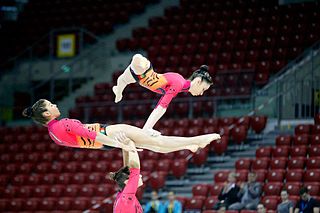
Gymnastics is a type of sport that includes physical exercises requiring balance, strength, flexibility, agility, coordination, artistry and endurance. The movements involved in gymnastics contribute to the development of the arms, legs, shoulders, back, chest, and abdominal muscle groups. Gymnastics evolved from exercises used by the ancient Greeks that included skills for mounting and dismounting a horse, and from circus performance skills.

In gymnastics, the floor is a specially prepared exercise surface, which is considered an apparatus. It is used by both male and female gymnasts. The gymnastics event performed on the floor is called floor exercise. The English abbreviation for the event in gymnastics scoring is FX.

Trampolining or trampoline gymnastics is a competitive Olympic sport in which athletes perform acrobatics while bouncing on a trampoline. In competition, these can include simple jumps in the straight, pike, tuck, or straddle position to more complex combinations of forward and/or backward somersaults and twists. Scoring is based on the difficulty and on the total seconds spent in the air. Points are deducted for bad form and horizontal displacement from the center of the bed.

The uneven bars or asymmetric bars is an artistic gymnastics apparatus. It is made of a steel frame. The bars are made of fiberglass with wood coating, or less commonly wood. The English abbreviation for the event in gymnastics scoring is UB or AB, and the apparatus and event are often referred to simply as "bars". The bars are placed at different heights and widths, allowing the gymnast to transition from bar to bar. A gymnast usually adds white chalk to the hands so that they can grip the bar better.
Artistic gymnastics is a discipline of gymnastics in which athletes perform short routines on different apparatuses. The sport is governed by the Fédération Internationale de Gymnastique (FIG), which assigns the Code of Points used to score performances and regulates all aspects of elite international competition. Within individual countries, gymnastics is regulated by national federations such as British Gymnastics and USA Gymnastics. Artistic gymnastics is a popular spectator sport at many competitions, including the Summer Olympic Games.

A somersault is an acrobatic exercise in which a person's body rotates 360° around a horizontal axis with the feet passing over the head. A somersault can be performed forwards, backwards or sideways and can be executed in the air or on the ground. When performed on the ground, it is typically called a roll.

The Code of Points is a rulebook that defines the scoring system for each level of competition in gymnastics. There is not a universal international Code of Points, and every oversight organization — such as the FIG, NCAA Gymnastics, and most national gymnastics federations — designs and employs its own unique Code of Points.

Equestrian vaulting, or simply vaulting, is most often described as gymnastics and dance on horseback, which can be practiced both competitively or non-competitively. Vaulting has a history as an equestrian act at circuses, but its origins stretch back at least two-thousand years. It is open to both men and women and is one of ten equestrian disciplines recognized by the International Federation for Equestrian Sports. Therapeutic or interactive vaulting is also used as an activity for children and adults who may have balance, attention, gross motor skill or social deficits.

A handspring is an acrobatic move in which a person executes a complete revolution of the body by lunging headfirst from an upright position into an inverted vertical position and then pushing off from the floor with the hands so as to leap back to an upright position. The direction of body rotation in a handspring may be either forward or backward, and either kind may be performed from a stationary standing position or while in motion.

Mitsuo Tsukahara is a Japanese artistic gymnast. He was five times an Olympic Gold Medalist. He remained active in the sport after his retirement from competition. He served as vice president of the Japan Gymnastic Association.

Yurchenko, also known as round-off entry vaults, are a family of vaults performed in artistic gymnastics in which the gymnast does a round-off onto the springboard and a back handspring onto the horse or vaulting table. The gymnast then performs a salto, which may range in difficulty from a simple single tuck to a triple twist layout. Different variations in the difficulty of the salto lead to higher D-scores. This family of vaults is the most common type of vault in gymnastics and it's named after Natalia Yurchenko, who first performed it in 1982.

United States of America Gymnastics is the national governing body for gymnastics in the United States. Established in 1963 as the U.S. Gymnastics Federation (USGF), USA Gymnastics selects and trains the men's and women's national teams for the Olympic Games and World Championships. USAG sets the rules and policies that govern the sport of gymnastics, promotes the sport at all levels, and serves as a resource center for members, clubs, fans and gymnasts.

Valeri Viktorovich Liukin is a Soviet-born Kazakh-American retired artistic gymnast turned gymnastics coach. As a competitor for the former Soviet Union, Liukin was the 1988 Olympic champion in the team competition and individually on the horizontal bar, and Olympic silver medalist in the all-around and the parallel bars.

Acrobatic gymnastics is a competitive discipline of gymnastics where partnerships of gymnasts work together and perform figures consisting of acrobatic moves, dance and tumbling, set to music. There are three types of routines; a 'balance' routine where the focus is on strength, poise and flexibility; a 'dynamic' routine which includes throws, somersaults and catches, and a 'combined' routine which includes elements from both balance and dynamic.

Tumbling, sometimes referred to as power tumbling, is a gymnastics discipline in which participants perform a series of acrobatic skills down a 25 metres (82 ft) long sprung track. Each series, known as a pass, comprises eight elements in which the athlete jumps, twists and flips placing only their hands and feet on the track. Tumblers are judged on the difficulty and form of their routine. There are both individual and team competitions in the sport.
A trampette is a small square trampoline used in gymnastics. In TeamGym, the trampette is positioned at the end of a runway in front of a mat. The trampette is adjusted at an angle, tilted towards the gymnast, who approaches the trampette at a run. The gymnast jumps onto the trampette and performs a somersault, landing on the mat. Part of the TeamGym trampette program is performed with a vaulting apparatus, which is positioned between the trampette and the mat.
This is a general glossary of the terms used in the sport of gymnastics.

Double mini trampoline, sometimes referred to as double mini or DMT, is a gymnastics discipline within trampolining. Participants perform acrobatic skills on an apparatus smaller than a regular competition trampoline. The apparatus has both an angled section and a flat section. Unlike individual trampoline, where scoring is predominantly determined by Execution, Time of Flight and Difficulty, the Difficulty in DMT plays a more prominent role in the final score.
There are currently five elements in the Women's Artistic Gymnastics Code of Points named after American gymnast Simone Biles: two on vault, one on balance beam, and two on floor exercise.














